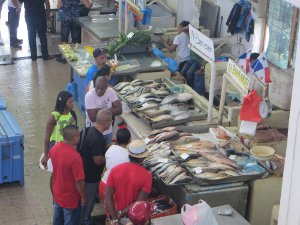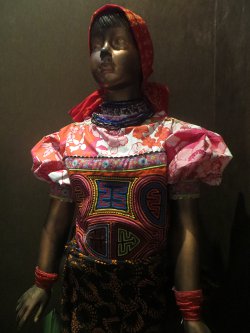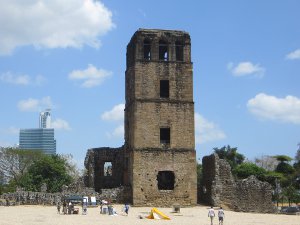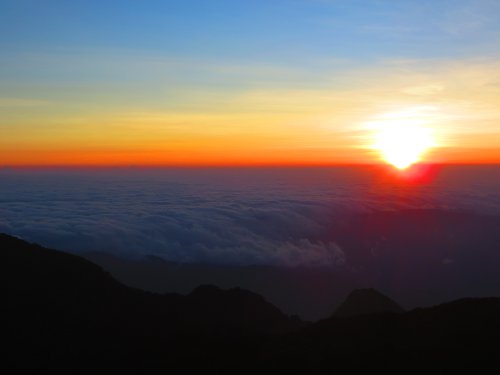Sights and Activities
Below are the places we saw and activities completed while visiting Panama:
Panama City
Mercado de Mariscos: we had a seafood lunch in a second-floor restaurant overlooking this seafood market.
Iglesia de la Merced: the stone façade of this church was moved piece by piece from its original location in Panama Viejo to the new city by the year 1680. We were able to visit the interior.


Iglesia San Jose: this church is home to the Altar de Oro (Golden Altar), which was salvaged after Henry Morgan raided Panamá Viejo. There is a local legend that a priest painted the altar black to disguise it when he heard of the pirate’s attack. The priest told Morgan that the gold altar had been stolen by another pirate and convinced Morgan to donate for its replacement. Morgan allegedly told the priest, “I don’t know why, but I think you are more of a pirate than I am.” We went inside to see the altar that was later moved from the Panama Viejo to its present site in Casco Antiguo.

Plaza de la Independencia: this plaza is the heart of Casco Antiguo and was the site where Panama declared its independence from Colombia on November 3, 1903. It is also home the the city’s cathedral.
Iglesia San Francisco de Asis: this small, but ornate church sits on Plaza Bolivar. It was ravaged by fire in 1737 and again in 1756 and restored in 1998.
Teatro Nacional: this theater was built in 1907 and has been completely restored.
Plaza de Francia: this plaza is located at the tip of the southern point of Casco Antiguo and pays homage to the French role in the construction of the canal.
Paseo las Bovedas: this esplanade runs along the top of the sea wall built by the Spanish to protect the city.
Museo de Historia de Panama: this museum contained exhibitions on the country’s modern history, such as indigenous attire, independence from Spain as part of Colombia, independence from Colombia, a little bit on the construction canal, Noriega’s dictatorship, and Panamanian control of the canal.

Museo del Canal Interoceanico: this museum dedicates its presentations on historical and political context of the famous canal. The exhibits run from how the Spanish would transport their goods by train before the canal, the France’s attempt to build the canal, life of the US citizens building the canal, the control of the canal by the US, the struggle by the Panamanians to retain control of the canal, and to finally the transition back to the Panamanians.
Museo Afro-Antilleano: this tiny museum was about the history of African descendents that were brought from neighboring islands, particularly the work they did on the railroad and later the canal.
Museo de Sitio Panama Viejo: this museum exhibited artifacts and a scale model of the first city in the pacific built by the Spanish that was later destroyed by Henry Morgan and his pirates.


Panama Viejo Ruins: the city of Panama was founded in 1519 on this site. When the city fell to Henry Morgan in 1671, the city contained a cathedral, several churches, thousands of colonial homes, and hundreds of warehouses stocked with foreign goods. The government declared the ruins a protected site in 1976 and UNESCO followed in 1997, but most of the old city had already been dismantled and overrun. We were able to see the remains of the cathedral with its stone tower, the plaza beside it, the convent of Santo Domingo, the Iglesia de San Jose, the hospital of San Juan de Dios, and the city hall.

Calzada (Causeway): at the Pacific entrance to the Panama Canal this Causeway is popular with residents to come to walk, jog, skate, and cycle. The walkway connects the islands of Flamenco, Perico, Culebra, and Naos to the mainland and offers spectacular views of the skyline. We took a bus to the last island, Flamenco, and walked the 2km back.
Museo de la Biodiversidad: we saw this multi-layered, multi-colored structure designed by renowned architect Frank Gehry from the exterior. The building is home to a museum on biodiversity, which we did not visit.
Miraflores Locks of the Panama Canal: we were able to witness a couple of ships pass these locks of the Panama Canal, one of the world’s greatest engineering marvels. Inaugurated in 1914, the canal stretches 80km from Panama City on the Pacific side to Colon on the Atlantic side. Around 13,000 vessels pass through the canal each year and ships worldwide are built with the dimensions of the Panama Canal’s locks (305m long and 33.5m wide) in mind. Ships pay according to their weight, with the average fee around US$30,000. The highest amount paid was around US$ 376,000, paid in 2010 by the cruise ship Norwegian Pearl; and the lowest amount was US$0.36, paid in 1928 by Richard Halliburton, who swam through. Panamanians voted to expand the canal in 2006. The expansion was originally planned to open for the canal’s 100-year anniversary, but it was still not inaugurated at the time of our visit in February 2016. This location of the locks also has a four-story museum that displayed the history, construction, and expansion of the canal.

Perro Grande Island
We had an amazing opportunity to visit one of over 365 islands in the San Blas archipelago, also known as the Kuna Yala archipelago. Although the cost of the entire trip to the island was larger than what we would have liked, the small-island feel, the solitary, and best of all the turquoise waters made all the expenses worthwhile. The region is home to the Kuna, the first group in Latin America to gain indigenous autonomy. You can read more about this indigenous group and our tranquil time in their territory in our article.

Lago Bay
All of our WWOOFing experiences have been unique. This one in particular was different in the sense that instead of it being a farm or orchard, it was actually an investment property with construction and gardening projects. The owner, from the United States, had bought the land and subdivided it to sell and form a community. We spent 18 days working on projects such as planting seeds, transplanting, collecting compost, creating structural details for construction, cooking, and building a nursery for an aquaponics project. Be sure to read more about our experience in our article.
Santa Catalina
We took a day trip from Lago Bay to visit this surf town. Most of the time we spent laying out and seeing the waves of the Pacific Ocean. We also walked to the Estero Beach, but unfortunately we did not try surfing or even get into the water.

Boquete
Baru Volcano National Park: this 143-sq-km national park is home to the Baru Volcano, which is Panama’s only volcano. Its summit, which tops out at 3475m (11,400ft), is the highest point in Panama. Our plan was to trek the strenuous uphill 14km (8.7 miles) trail, which we started to, but after about 5km (about 2 hours) we were picked up by a service 4×4 vehicle that was headed up to check on some antennas. We were able to set camp at the top and the next morning see the sunrise along with the Pacific Ocean. Unfortunately, the Carribean side was too cludy to be able to see water. After enjoying the view, we headed down the trail, this time walking the full length that took us about 4 hours.

